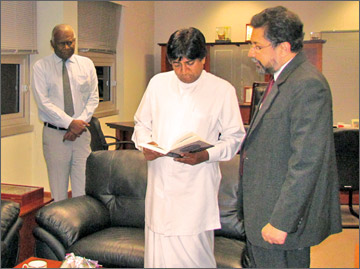An indepth analysis of migration
Migration has played an important role on the course of development
of many developing countries.
This is particularly so with respect to South Asia. Migration,
Remittances and Development in South Asia, edited by Saman Kelegama,
explores the impact of migration on development in South Asian countries
and makes recommendations for benefiting more from out-migration and
reducing the ill effects of it. It is policy oriented and recommends
policies for each of the eight countries and the region as a whole.
There is also a proposal for a Commission on migration in South Asia.
 |
|
The Institute of Policy Studies
Executive Director Dr Saman Kelegama presenting his latest
book on Migration, Remittances and Development in South Asia
to Foreign Employment Minister Dilan Perera. |
|
BOOK REVIEW
Migration, Remittances and Development in South Asia
Saman Kelegama (Editor), Sage Publications, India, pp. 372, 2011
Reviewed by Nimal Sanderatne |
Remittances have tended to be viewed as an adjunct to issues in
development despite its recognition as a contributor to various facets
of development.
This book goes further to examine how migration should be brought
into the mainstream of development planning and directed in a manner
that migration, just as much as other population changes, are an
integral part of the development factors.
It contends that development must be conceived of, and understood as,
a dynamic process with the goal of enlarging the scope of human choices
and creating an environment where citizens can live with dignity and
equality. This book of 11 chapters consists three parts. It begins with
an introduction to the book by the editor that brings out salient issues
related to migration and gives an overview of the country studies and
the policy recommendations.
This is invaluable to readers who may select only some case studies.
The overview summarizes the features of each country situation and
policy issues.
The second section has the eight country studies of South Asia. The
third section consists of two chapters, one that argues the case for
policy measures to improve the migration conditions and the other that
argues for a Commission on migration in South Asia.
The eight chapters on the individual South Asian countries that are
in-depth studies, document both the benefits and adverse impact of
out-migration and highlights the problems and challenges faced by these
countries. Most countries of South Asia depend on remittances to
strengthen their balance of payments and contribute to GDP. More
important is the fact that the living conditions of the poor have
improved owing to remittances from migration. There are several problems
encountered by the migrants and although livelihoods have improved,
remittances have often resulted in aggravating inequality.
The book brings out these benefits and adverse impacts in a balanced
manner.
Although the Indian diaspora is large and has been building up over
the years, it is mostly the newer migrants to the Middle East that make
a significant contribution to the country through remittances. Although
India receives a large amount of remittance inflows, the largeness of
the Indian economy makes such remittances contribute only three percent
to GDP.
However, remittances have contributed to the alleviation of poverty
and improvement of social welfare. The author of the chapter makes a
special study of the effects of out-migration from Kerala.
The state of Kerala is the most significant in out-migration and
out-migration from it has enabled families of migrants to buy land,
improve housing, and invest in education and healthcare.
However, only a quarter of Kerala families benefited directly from
remittances and since they were already better off than non-migrant
families, out-migration has increased economic inequality.
In Pakistan, out-migration provided jobs and raised wages for workers
who remained behind, but remittances flowed primarily to urban areas,
increasing the rural-urban income gap and encouraging rural-urban
migration.
Remittance levels have been rising and accounted for 10 per cent of
GDP during peak times.
In the case of Sri Lanka, the significance of migration to the
balance of payments and the economy is of such a magnitude that the Sri
Lankan economy has been described as a remittance-dependent economy.
About 80 per cent of the huge trade deficit of US$ 5.2 billion in
2010 was offset by remittances from abroad.
It is estimated that remittances contributed eight per cent to GDP in
2008. The situation in Sri Lanka is very similar with Bangladesh, Nepal
and Pakistan, where remittances are not only a support to the trade
balance but an important way by which the country’s poverty is
alleviated.
|



